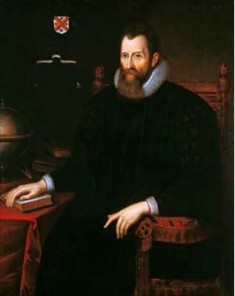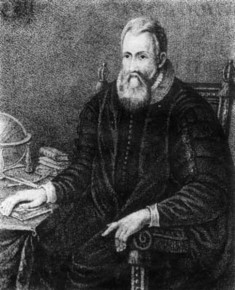| John Napier | |
|---|---|
 |
|
| Mathematician | |
| Specialty | Physics, astronomy |
| Born | 1550 Merchiston Tower, Edinburgh |
| Died | Apr. 4, 1617 (at age 66–67) Edinburgh |
| Nationality | Scottish |
John Napier, who also went by Marvellous Merchiston, was a popular Scottish landowner, physicist, mathematician and astronomer. John was the 8th Laird of Merchistoun. Today, he is best known as the inventor of logarithms. John also invented Napier’s bones and even made common the use of decimal point in mathematics and arithmetic.
Early Life
John was born in 1550 in Edinburgh. His father was Sir Archibald of Merchiston Castle and his mom was Janet Bothwell, a politician’s daughter. Sir Archibald was only 16 years when his son John was born. As a common practice amongst members of the nobility, John did not join school until he was 13 years old. However, he did not remain in school for long either. It is believed that he dropped out of school in Scotland and travelled to Europe to further his studies. Some historians claim that he studied in some universities on Italy and France.
In 1571, when he was 21 years, John Napier went back to his homeland and married Elizabeth Stirling after one year. He also bought a castle at Gartness in 1574. In 1608, he lost his father and John and his family moved into Merchiston Castle located in Edinburgh. He remained here for the remainder of his life.
Contributions to Mathematics
In 1614, John published his first work – Mirifici Logarithmorum Canonis Descriptio. This book contained 57 pages of different explanatory matter and 90 pages of tables of numbers that are related to natural logarithms. The book contains a great discussion of different theorems in spherical trigonometry. John’s invention of logarithms was fast taken up at Gresham College.
In 1615, Henry Briggs, a prominent English mathematician, visited John. Some of the issues they discussed were re-scaling Napier’s logarithms where the presence of mathematical constant e was a practical difficulty.
Napier also made further contributions in mathematics. For one thing, he improved Simon Stevin’s decimal notation. He also introduced Napier’s bones, which is a multiplication tool that uses numbered rods.
Napier and Theology
 John had a great interest in the Book of Revelation. He was also influenced by sermons of Christopher Goodman and therefore, he developed a very strong anti-papal reading. He used the Book of Revelation for a timeline of sorts in order to predict the Apocalypse. He also applied Sibylline Oracles to calculate the date the world would end. He believed that this would occur either between 1688 or 1700. He even dated the seventh trumpet to 1541.
John had a great interest in the Book of Revelation. He was also influenced by sermons of Christopher Goodman and therefore, he developed a very strong anti-papal reading. He used the Book of Revelation for a timeline of sorts in order to predict the Apocalypse. He also applied Sibylline Oracles to calculate the date the world would end. He believed that this would occur either between 1688 or 1700. He even dated the seventh trumpet to 1541.
In 1594, John dedicated a book called Plaine Discovery to James VI. He tried to convince the king to see that justice was served against all the enemies of God’s church. He advised the king to reform the universal enormities of the country beginning with his house, family, and court. The book was a great success both at home and abroad.
Napier’s Other Works
During the late 16th century, a Calvinist was trying to drive away Catholicism from Scotland. In 1594, Napier revolted against this using a book. John decided to set up four new types of weapons to make this struggle even more powerful. His weapons included an artillery piece. This was a kind of battle vehicle covered with plates of metal and had very tiny opening for emitting odious smoke, firepower two 2 kinds of burning mirrors. This vehicle was driven by men inside. Soon after, the called the Spanish conquest was over and this meant John had to go back to his work.
Napier and the Occult
Apart from his mathematical and religious interests, John was often seen as a magician. He is actually thought to have dabbled in necromancy and alchemy. Many people said that he used to travel around with a black spider in a tiny box. Many also believed that his black rooster was his familiar spirit.
Influence on Mathematicians
The instrument makers – John Speidell and Edmund Gutter – were some of Napier’s closest followers. His contributions in logarithms are given credit as the largest single factor in the adoption of decimal arithmetic.
Today an alternative unit to the decibel is used in electrical engineering, the neper. This is named after Napier. The crater Neper on the Moon is also named after him.
Personal Life
In 1572, John Napier married Elizabeth Stirling and together they had two children. His wife died in 1579 and he remarried Agnes Chisholm. Together the couple had ten more children. He died on April 4, 1617 in Edinburgh.